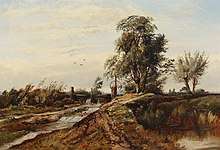John Berney Crome
| John Berney Crome | |
|---|---|
 Portrait of Crome by George Clint c.1820 (Norfolk Museums Service) | |
| Born |
1 December 1794 Norwich |
| Died |
15 September 1842 (aged 47) Norwich |
| Nationality | English |
| Known for | Landscape painting |
| Movement | Norwich School of painters |

John Berney (or Barney) Crome (1 December 1794 – 15 September 1842) was an English landscape and marine painter associated with the Norwich School of painters. He is sometimes known by the nickname 'Young Crome' to distinguish him from his father John, known as 'Old Crome'.
Life
_Estuary_-_Google_Art_Project.jpg)
John Berney Crome was born in Norwich, Norfolk, on 1 December 1794,[1][2] the eldest of the seven surviving children of John Crome (1768–1821), painter, and his wife, Phoebe Berney. His father was a distinguished landscape artist and a founder of the Norwich Society of Artists. Realising his own educational deficiency, he determined his son should have a good education, and John Berney Crome attended Norwich School – the Grammar School - until he was eighteen. At the same time, with ambitions of becoming an artist, he accompanied his father on sketching expeditions. In 1816 he went with his school friend George Vincent, and a doctor, Benjamin Steel (who afterwards married Crome’s sister) on an excursion to Paris.
Crome assisted his father in teaching and was appointed as landscape painter to the Duke of Sussex. He became a member of the Norwich Society of Artists and exhibited many of his pictures there between 1806 and 1830. He was appointed Vice-President of the Society in 1818, and subsequently President on several occasions. [3]
On the death of John Crome in April 1821, John Berney Crome continued his father's art teaching practice and occupied the family house in Gildengate Street, Norwich, to which he added a studio. In conjunction with John Sell Cotman, he took a lively interest in the Norwich Society of Artists in 1828, which had closed in 1825 after the demolition of its old premises. Between 1811 and 1843 he had many works exhibited at the Royal Academy, British Institution and Society of British Artists in London, and made trips to the continent, drawing and painting in France, Holland, Belgium and Italy. His work shows the influence of his father, and like his father he painted many moonlight effects, his 1834 River Scene By Moonlight being a prime example.
As a result of his extravagant habits, Crome was made bankrupt in 1831, and the contents of his father's house had to be sold off. Many paintings made by both father and son were disposed of at this time. He subsequently moved to Great Yarmouth in 1835, where he continued to teach drawing until his death on 15 September 1842.
Crome was twice married, but had no children. He was known as a man of genial character and jovial disposition, and his portrait, one of two executed by H B Love, hangs in the Castle Museum, Norwich.
Works
John Berney Crome worked in oils, watercolours and pencil, painting coastal and rural scenes, both at home and abroad. Many of his Crome’s works were exhibited at the Royal Academy, Edinburgh Society of Artists and the Society of British Artists. Norfolk Museums has a significant collection of his work, most housed in the Castle Museum, and his paintings are also currently kept by the Tate Gallery, the Yale Centre for British Art, the UK Government Art Collection, the Sheffield Museums, the Royal Albert Memorial Museum, Oxford Town Hall, the Williamson Art Gallery & Museum, the Barber Institute of Fine Arts, and the English Heritage Collection, Kenwood.
While John Berney Crome’s paintings have never reached the status associated with the great English landscape artists, some have fetched almost $10,000, and in 2018 a relatively small (perhaps 37cm by 32cm) oil on canvas painting of a shoreline landscape marine scene was offered for sale through Madrigallery in the USA for $35,000.
Notes
- ↑

- ↑ Holme Geoffrey (Ed.). The Norwich School (The Studio Ltd., 1920) pp. 27-8.
- ↑ Far from creating pastiches of the Dutch 17th century, Crome and John Sell Cotman, along with Joseph Stannard, established a school of landscape painting which deserves greater fame; the broad washes of Cotman's water-colours anticipate French impressionism. One reason the Norwich School artists are not so well known as other painters of the period, notably Constable and Turner, is because the majority of their canvases were collected by the industrialist J. J. Colman (of Colman's mustard), and have been on permanent display in Norwich Castle Museum since the 1880s. This lack of wider exposure was remedied in 2001, when many of the school's major works were exhibited outside Norwich for the first time at the Tate Gallery, London in 2000.
External links
| Wikimedia Commons has media related to John Berney Crome. |
- 45 works by John Berney Crome (and a number of portraits of the artist) in the Norfolk Museums Collections
- 1 work (Moonlight (undated)) by John Berney Crome at the Tate Gallery
- 35 works by John Berney Crome from Art UK
- 2 works by John Berney Crome in the Yale Center for British Art, New Haven, Connecticut
- 96 works by John Thirtle at Artnet
- 13 works by John Berney Crome at the British Museum
- Works by (or attributed to) John Berney Crome sold at auction according to Invaluable